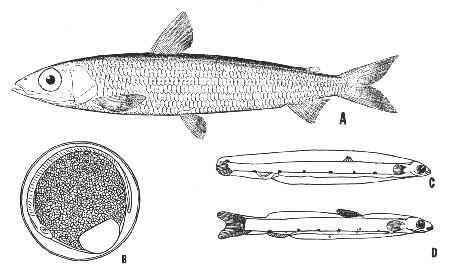Argentine Argentina silus Ascanius 1763
HERRING SMELT
[Jordan and Evermann, 1896-1900, p. 526.]

Figure 59.—Argentine (Argentina silus). A, adult, Biddeford Pool, Maine; from Goode and Bean, drawing by H. L. Todd; B, egg; C, larva, 28 mm.; D, larva, 45 mm. B-D, European, after Schmidt.
Description—
The argentine has a pointed nose, deeply forked tail, and slender, compressed body, but it has much larger eyes than either smelt or capelin, a character no doubt associated with its deep-water home; its mouth is much smaller, not gaping back even as far as the eye; and its dorsal fin stands wholly in front of the ventrals, instead of above them as it does in both the smelt and the capelin.[22]
The body of the argentine (about one-fifth as deep as long) tapers toward both head and tail, but its sides are so flat, and its back and belly so broad, that it is nearly rectangular in cross section instead of oval. Its scales, too, are larger than those of the smelt, there being only 60 to 70 rows along the lateral line. Its adipose fin is very small and its jaws are toothless, though its palate and tongue are armed with small teeth.
Color—
The color of the adult is variously described by different authors. All agree, however, that the back is brownish or olivaceous, the sides silvery or with iridescent golden or brassy luster, and the belly white. The adipose fin is yellowish.
Size—
The argentine is a larger fish than the smelt or the capelin, growing to a length of about 18 inches.
Habits—
Nothing is known of the life of the herring smelt in our Gulf, and little enough is known of it in Scandinavian waters, where it is sometimes caught on deep set-lines baited with herring or mussels, and where it is occasionally [page 140] swept up to the surface like other deep-sea fishes by some upwelling of the water, to drift there helplessly. Its eggs float chiefly in the deeper water layers, seldom rising to the surface, and they are among the largest of buoyant fish eggs (3 to 3.5 mm. in diameter), with flat oil globule (0.95 to 1.16 mm.) and vacuolated yolk. Newly hatched larvae are about 7.5 mm. long and have a large yolk sac, but this has been absorbed when they have grown to a length of 12 mm. and a line of spots has appeared along the belly. The fin rays are formed by the time the little fish has reached 45 mm., the anus has moved forward, and the forked outline of the tail is apparent, but the ventral fins do not appear until the larva is about 50 mm. long.
General range—
North Atlantic, usually in water as deep as 80 to 300 fathoms; known from northern Norway south to the northern part of the North Sea on the European side, from the Nova Scotia Banks to the offing of southern New England on the American side.[23]
Occurrence in the Gulf of Maine—
The argentine was considered rare in our waters until recently. Some specimens have been brought in from widely scattered localities around the coast, namely, Belfast, Biddeford Pool, and Fletchers Neck, Maine; and from Hampton Beach, N. H. It has proved, with the development of otter trawling, that argentines are fairly common all around the edges of Georges Bank and off Cape Cod in moderately deep water. It is not unusual for one haul of the trawl to bring in from one to a dozen from depths of 30 to 100 fathoms, with much larger numbers taken occasionally; one vessel, for example, trawled 15,000 pounds on the northeastern edge of Georges Bank in about 100 fathoms during a week in mid-September 1929. Evidently there are at least a few argentines in the deep trough of the Gulf also. Firth[24] reports that ten were taken at 90 fathoms on the northwestern slope of Georges Bank on June 18; and the Albatross II trawled one at 115 fathoms off Mount Desert Rock. They spawn to some extent in the Gulf, for on April 17, 1920, a townet haul on the Albatross I from 109 fathoms in the southeastern part of the Gulf basin yielded 43 eggs, unmistakably of argentine parentage, while we have taken a scattering of argentine fry at localities as widely separated as the offing of Mount Desert Rock and the northwestern edge of Browns Bank.
[22] The anatomy of Argentina silus is described, and records along the American coast are given by Kendall and Crawford (Jour. Washington Acad. Sci., vol. 12, No. 1. January 1922, pp. 8-19).
[23] For recent records of argentines off Nova Scotia, see McKenzie and Homans, Proc. Nova Scotia Inst. Sci., vol. 19, No. 3, 1938, p. 277 and McKenzie. Proc. Nova Scotia Inst. Sci, 20, 1939, p. 15.
[24] Firth, Bull. Boston Soc. Nat. Hist., 61, 1940, p. 10.